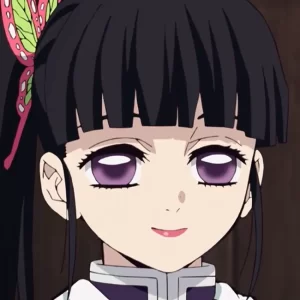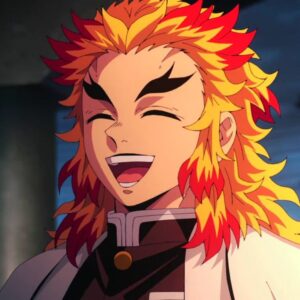Genre: Adventure, Dark fantasy, Martial arts
Season: 1
Episodes: 55
Director: Haruo Sotozaki
Studio: Ufotable
Original Airtime: April 6, 2019 – present
Plot:
Devastated by the loss of his family and determined to find a cure for his sister’s condition, Tanjiro decides to become a demon slayer and seeks vengeance against the demons responsible for his family’s demise. He joins the Demon Slayer Corps, an organization that fights demons and protects humanity.
Tanjiro’s main goal is to find a way to turn Nezuko back into a human while battling powerful demons and uncovering the secrets of their existence. Along his journey, Tanjiro forms close bonds with other demon slayers, each with their own unique skills and tragic backgrounds. He also uncovers a broader conspiracy involving powerful demons and the mysterious organization that supports them.
Storyline: 8/10
Meet Tanjiro Kamado, a kind-hearted and clever young boy who lives in the mountains with his family. After his father’s passing, he takes on the responsibility of providing for his family by selling charcoal in the nearby village.
One tragic day, Tanjiro returns home to a horrifying scene – his family has been brutally attacked and killed by a demon. His only surviving family member, his sister Nezuko, has been turned into a demon herself. Surprisingly, Nezuko retains traces of her human emotions and thoughts despite her transformation. After an encounter with Giyu Tomioka, a high-ranking member of the Demon Slayer Corps, Tanjiro is recruited and sent to Sakonji Urokodaki, a retired master, to train as a Demon Slayer. His goal is to find a way to turn Nezuko back into a human.
Following two years of rigorous training, Tanjiro learns the “Water Breathing” style and successfully passes a challenging exam, officially becoming a member of the Demon Slayer Corps. He joins forces with Nezuko, who has been conditioned to avoid harming humans, and they embark on a mission to eliminate demons. Throughout their journey, Tanjiro and Nezuko meet allies like Zenitsu Agatsuma and Inosuke Hashibira. They form a team and face formidable demons, including Rui and Akaza. Along the way, they forge strong bonds with their comrades and develop their skills to take on increasingly powerful foes.
Tanjiro’s ultimate goal is to defeat Muzan Kibutsuji, the progenitor of all demons, who was responsible for the attack on his family. Alongside his friends and allies, Tanjiro works towards finding a way to cure Nezuko’s condition, which leads them to seek blood samples from the Twelve Kizuki, the strongest demons under Muzan’s command. As they continue their battles and encounters, Tanjiro and his group face challenges, losses, and sacrifices. They confront the Infinity Castle, the lair of Muzan, and engage in a final, desperate battle against him. Tanjiro is pushed to his limits and ultimately turns into a demon himself in the heat of the confrontation. With the help of his friends and sister, Tanjiro manages to return to his human form, leading to a final showdown with Muzan. The Demon Slayer Corps emerges victorious, but not without significant losses. After Muzan’s defeat, the Corps disbands, and the surviving members return to a peaceful life.
Characters: 8/10
These are just a few of the major characters in “Demon Slayer.” The series features a diverse cast of characters, each with their own unique abilities, personalities, and backstories that contribute to the rich storytelling of the series.

Tanjiro Kamado
The protagonist of the series, Tanjiro is a kind-hearted and determined young boy who becomes a Demon Slayer after his family is slaughtered by demons. He possesses a strong sense of justice and is on a quest to turn his sister Nezuko back into a human and avenge his family.

Nezuko Kamado
Tanjiro's younger sister who survives the demon attack but is turned into a demon herself. Despite her transformation, she retains her humanity and emotions, which is unusual for demons in the series. She accompanies Tanjiro on his journey as he seeks a way to cure her condition.

Giyu Tomioka
Also known as the Water Hashira, Giyu is a high-ranking member of the Demon Slayer Corps. He is the one who recruits Tanjiro into the organization and provides guidance and training to him. Giyu is stoic and skilled in water-based sword techniques.

Zenitsu Agatsuma
Zenitsu is another survivor of the Demon Slayer Corps' entrance exam. He is known for his cowardice and fear of demons, but he possesses incredible lightning-based sword skills. Despite his initial fears, he grows in courage and determination.

Inosuke Hashibira
Inosuke is a wild and aggressive member of the Demon Slayer Corps with a boar's head mask. He has a fierce personality and fights using dual swords. Despite his rough exterior, he has a unique connection with nature and animals.

Muzan Kibutsuji
The primary antagonist of the series, Muzan is the progenitor of all demons. He seeks to eliminate Demon Slayers and achieve ultimate power, and he is responsible for turning Nezuko into a demon. His defeat is the ultimate goal of the Demon Slayer Corps.

Kanao Tsuyuri
Kanao is a skilled Demon Slayer and one of the survivors of the Final Selection exam. She is a disciple of Shinobu Kocho, the Insect Hashira, and possesses the ability to see the flow of a person's emotions. She has a quiet and reserved demeanor.

Shinobu Kocho
The Insect Hashira of the Demon Slayer Corps, Shinobu is known for her cheerful and sweet appearance, but she can be ruthless in battle. She uses poison-based techniques and has a strong desire to eliminate demons due to her traumatic past.

Kyojuro Rengoku
The Flame Hashira, Kyojuro is a powerful swordsman known for his intense passion and dedication to protecting humanity. He plays a crucial role during the Infinity Castle arc.

Tengen Uzui
The Sound Hashira, Tengen is a flamboyant and confident Demon Slayer who specializes in sound-based techniques. He is often accompanied by his wives, who are skilled fighters themselves.
Art and Animation: 7/10
Demon Slayer” (Kimetsu no Yaiba) is known for its exceptional art and animation quality. The anime adaptation, produced by Ufotable, received widespread acclaim for its stunning visuals, fluid animation, and attention to detail. The anime showcased intricate and detailed artwork, capturing the Taisho-era setting of the series with beautifully designed backgrounds, architecture, and landscapes.
One of the standout features of “Demon Slayer” was its fluid and dynamic animation. The action sequences, especially the battles against demons, were known for their smooth and impactful animations that added intensity to the fights. The fluid animation was further aided by the unique visual style that combined traditional Japanese aesthetics with modern animation techniques. This distinctive style helped the show stand out and created a captivating atmosphere.
Ufotable’s dedication to detail was evident in various aspects of the animation, such as character movements, facial expressions, emotions, clothing, and even the intricate designs of the demons. This attention to detail contributed to the immersive experience for viewers. It goes without saying that the anime’s direction and camera work can be compared to that of a cinematic experience. Scenes were framed creatively, and camera angles were chosen thoughtfully to enhance the storytelling.
Music: 7/10
The music composition in “Demon Slayer” was also widely praised for its impact on the series. The anime’s music, composed by Go Shiina and Yuki Kajiura, played a crucial role in enhancing the overall atmosphere, emotional depth, and intensity of the story. The anime’s soundtrack featured a mix of orchestral, traditional Japanese, and contemporary elements that contributed to the epic and emotional tone of the series. The music often elevated the impact of key moments, including intense battles and emotional scenes.
The battle music in “Demon Slayer” was particularly notable for its ability to synchronize with the action on-screen. The intense and rhythmic compositions added energy and excitement to the fight sequences. The music played a significant role in conveying the emotional depth of the characters and their struggles. The compositions enhanced moments of grief, determination, and camaraderie, making them more impactful for the viewers.
The opening and ending themes of “Demon Slayer” also contributed to its overall musical appeal. These songs often reflected the themes and moods of the series and became popular among fans.
Final Thoughts:
“Demon Slayer” has undeniably left a significant mark on the anime landscape, captivating audiences with its compelling story, exceptional animation, and captivating music. The series masterfully combines traditional Japanese aesthetics with modern storytelling techniques, resulting in a visually stunning and emotionally resonant experience. The animation quality is a standout aspect of the show, with Ufotable’s meticulous attention to detail and fluid animation bringing the intense battles and emotional moments to life in a truly captivating manner. The dynamic and creative direction, particularly during action sequences, adds a cinematic flair that immerses viewers in the world of the Demon Slayer Corps. The characters are well-developed and relatable, each with their own unique struggles and motivations. Tanjiro’s journey from a determined brother seeking to save his sister to a skilled Demon Slayer is a central thread that resonates with audiences. The supporting cast, including Zenitsu, Inosuke, and the Hashira, contribute depth and diversity to the story. Moreover, “Demon Slayer” manages to balance its darker themes with moments of humor and camaraderie, creating a well-rounded narrative that appeals to a wide range of viewers. The series explores themes of family, vengeance, humanity, and redemption, adding layers of complexity to the story’s foundation.
While it’s undeniable that “Demon Slayer” has garnered widespread acclaim, no piece of media is without its critiques. Some viewers might find certain story elements or character traits somewhat formulaic or familiar within the broader shonen anime genre. Additionally, because of its immense popularity, the series might carry high expectations that can affect individual viewing experiences.


